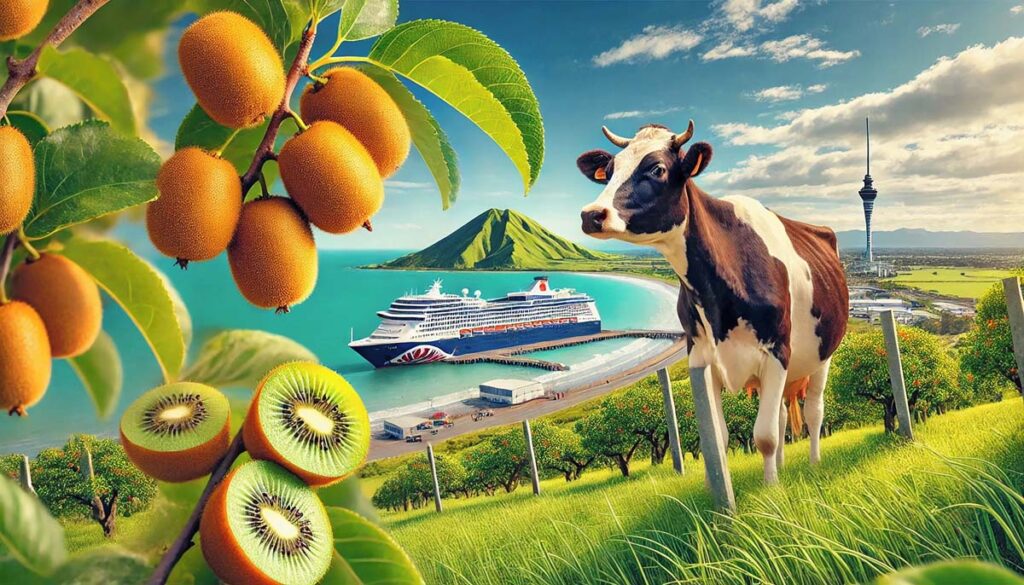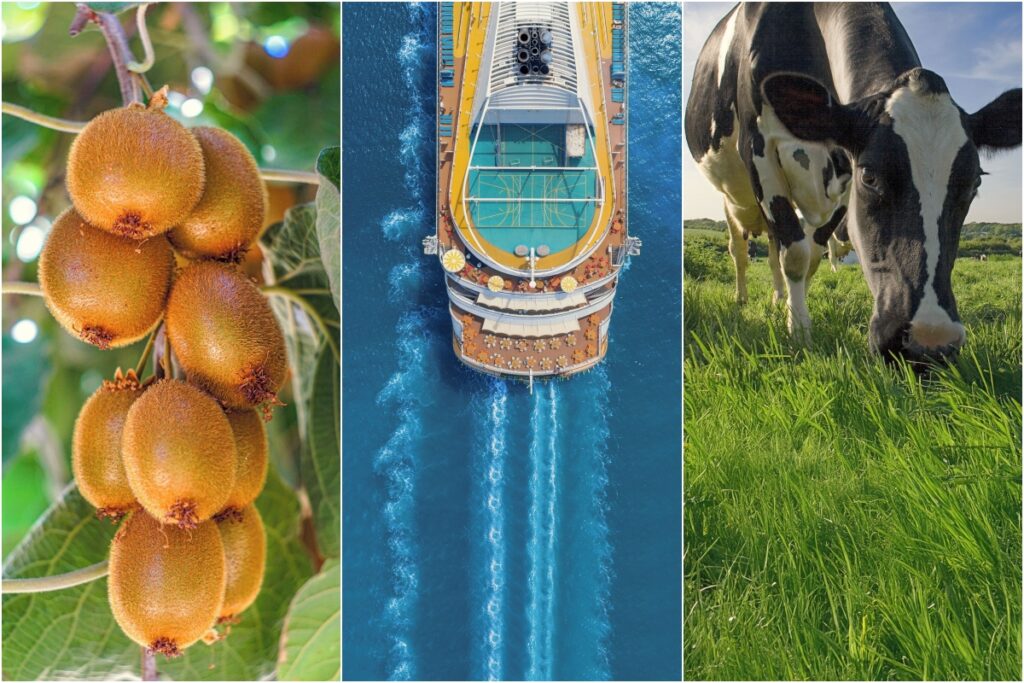
Cows, kiwifruit and cruise liners are all contributing to a surge in confidence and returns for the twin regions of Waikato and Bay of Plenty as export focused sectors are starting to build momentum after a tough couple of years.
Coast to coast, the two regions capture almost 20 per cent of the country’s export revenue with two of the country’s biggest earners, dairying and kiwifruit.
Both of these industries are poised to enjoy one of their best years yet, buoyed by strong market demand, a weaker dollar, compliant weather and lower interest rates.
This news comes on the back of confirmation that New Zealand enjoyed a slight lift in GDP over the December 2024 quarter, up 0.7%.
Although small, this increase is significant after the 1.1% decline in the September 2024 quarter.
Green light for kiwifruit
In February, Zespri released its final forecast for the 2024-25 season. It exceeded its longstanding global revenue target of $4.5 billion and follows strengthened tray returns for a record 190 million tray crop.
Zespri’s CEO, Jason Te Brake, confirmed it had been a very positive season benefitting from a solid lift in crop volumes after the previous year’s reduced volume – he expects the company will break its $4.5 billion target set in 2015.
“There is a strong sense of confidence within the industry with the successful industry discussion on expanding Zespri Global Supply (ZGS) at the end of 2024 showcasing our ability to make strategic decisions together,” he said.
The ZGS decision enables Zespri to significantly boost the volume of crops grown off shore to secure and maintain shelf space year round. Looking at this season’s harvest, Te Brake was equally upbeat.
“Growth conditions have been largely positive for most growers, with a total crop of more than 200 million trays, and our focus will be starting the season strongly with a good supply of high quality fruit.”
Estimates are this year’s harvest, of which 80% is from the Bay of Plenty, will crack the $3 billion export value mark for the first time, equalling earnings made from lamb exports.
Dairy profits flow
Waikato’s big dairy engine is revving again after a tough couple of years grappling with surging on-farm costs and a lower milk solid payouts.
Between them, the Bay of Plenty and Waikato account for almost 30% of the country’s $24 billion dairy exports. However, in the past two years dairy farm operating costs soared 30%, including stinging interest rate rises that had the average dairy farm debt cost soar from $187,000 a year in 2019 to $246,000 in 2024.
In a fortunate turnaround, strengthened commodity returns, falling interest rates and a lower NZ dollar have pushed the expected dairy payout for 2024-25 to more than $10 per kilogram of milk solids.
“Fonterra’s earnings and the forecast farm gate milk price have both benefitted from solid demand for our high value ingredients products and our sales book is well contracted for the season,” the dairy co-operative’s CEO Miles Hurrell said.
For the average Waikato or Bay of Plenty dairy farm facing operating costs of $8.32 per kg of milk solids, the $10 plus per kilogram pay out represents a healthy margin with which farmers can quit debt or reinvest back into their businesses with capital purchases.
It’s not only on land where one of these regions is experiencing a boom in returns.

Cruising through summer
In line with the rest of the country, Bay of Plenty has enjoyed higher spending by international visitors. This has helped offset a tough domestic market.
The 2024-25 summer season has resulted in a full-blown return of the cruise ship tourism sector to Bay of Plenty with almost 90 ships scheduled to arrive up until its official end on May 27.
Many visitors have been coming from Australia and delivering a welcome injection to the region’s tourist sites and retail trade, both of which have seen some tough going in recent months.
Oscar Nathan, general manager of Tourism Bay of Plenty, said spending by international visitors this summer is up 22% on January last year.
“This has contributed to a 3% increase in tourism jobs in our region across these timeframes. The most significant job gains were in travel and tour services with a 47% year-on-year increase in the Western Bay of Plenty, a 23% increase in Tauranga City and a 20% increase in the Whakatāne District.”
These increases come despite a slight drop in cruise ship visits, totalling almost 90, 14% less than last year.
As the main tourist season fades into autumn, the fourth Plenty of Flavours food festival kicked off from March 27 with multiple events sold out in advance.
New campaigns and promotions are getting underway with the government’s $3 million regional tourism boost fund focusing on two markets – Australia and North America – that do well with NZ’s exchange rate, Nathan said. He is also encouraged by direct flight services by JetStar, between Gold Coast and Sydney to Hamilton, set to begin in June.
Rotorua enjoying upside
The word ‘growth’ is also featuring in conversations with business owners in Rotorua,
The latest, biannual Rotorua Business Pulse report indicates growing confidence among the city’s business leaders. It reveals that 52% have been using ‘growth’ and ‘recovery’ in their survey responses.
Confidence in Rotorua’s tourism sector was also given a valuable boost with a mid-March announcement of a new 197 guest room lakeside hotel project. After decades of discussion about such a project, the hotel will add to Rotorua’s growing reputation as a health and wellness destination.
While feeling more optimistic about the coming year, business leaders are also tempering their views with one eye on international events and the emergence of a volatile world trade environment.
Rough road smoothing?
We have had a particularly rough road in New Zealand with prospects a full-blown recovery unlikely until later in the year, Craigs Investment Partners investment director, Mark Lister, told attendees at a recent PMG investment seminar.
And yet, he remained confident that interest rates here will continue to track down and that business confidence, in general, was on the up.
“Positivity is a leading indicator and it is now close to a 10 year high,” he said.
New Zealand is now enjoying a flat inflation period compared to the likes of Japan, USA, Europe and the United Kingdom where the three-month trend has been upward in nature.
“A large proportion of people have opted for short term rates, so a lowering of the OCR will see lower mortgage rates having a much quicker effect,” Lister said.
Kiwibank data shows 81% of mortgages with New Zealand’s five major banks are for durations of less than one year fixed term at present.
The strong commodity prices that have revealed themselves during the past few months bode well for shoring up the economies in the twin regions. This was supported by a recent Priority One economic update that highlighted the value of kiwifruit’s contribution against a relatively moribund construction sector.
Looking abroad, Lister said it was tough to disseminate Donald Trump’s tariff tactics between bluff and reality, but clients were well advised to look outside USA when investing at present.
“That includes looking at Japan, the European Union and emerging markets,” he added.
Lister did take heart from New Zealand’s relatively small trade surplus with the United States compared to larger trade partners, including Canada, which were drawing the president’s attention.
“We are not in the direct firing line,” Lister advised. “But the USA does take 13% of our exports, number two after China.”

